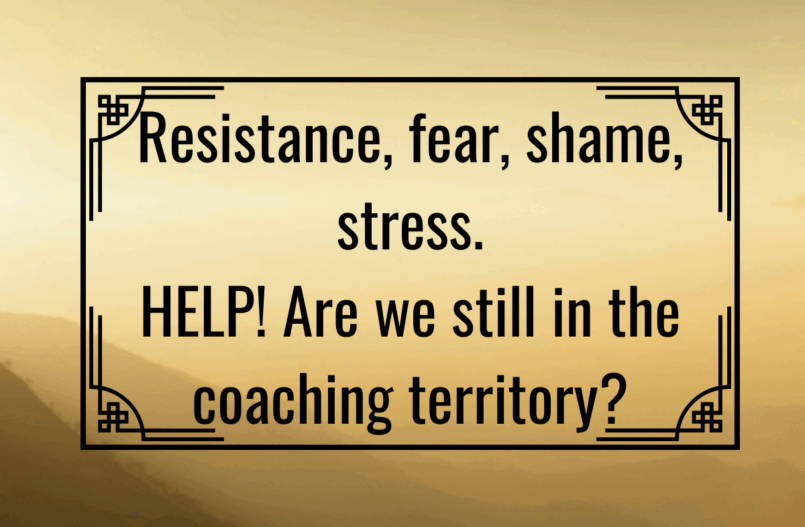This morning, I had a mentor coaching session with a PCC applicant. When she started to explore what was getting in the client’s way, the client brought up all of these:
Resistance. Fear. Shame. Stress.
How can you respond to that and work with that, if you have 20–30 minutes in your session?
Let me approach this conversation as a coach trainer and a mentor coach who got additional training in the ICF PCC Marker Assessment. I’ll be referencing not only core coaching skills but also PCC markers, which may be helpful to coaches who are getting ready for their PCC credential.

First, let me offer some reassurance: we are absolutely still in coaching territory.
When emotions show up, especially strong, layered ones like these, we’re not being taken off track. We’re being invited deeper in. These moments often bring us into the heart of what matters to the client. They are not problems to solve. They are experiences to be met with presence, compassion, and curiosity.
What can help you to deliver a valuable session to your client when so many heavy themes arise?
As emotions surface, the line between coaching and therapy may feel closer. But the boundary is clear. As coaches, we don’t diagnose or treat. We stay with the client’s lived experience in the present moment. Marker 6.3 reminds us that we can explore emotions, while Marker 7.5 allows us to offer observations or intuitions without attachment. Together, these markers support a conversation that is emotionally attuned, but still client-led, forward-focused, and within the scope of coaching. In staying relational, boundaried, and co-creative, we honour both the depth of the client’s process and their work in the session.
Coaching presence is key here. Your real, grounded quality of being and responding to the whole person, not just the presented topic. PCC Marker 5.1 asks us to respond to the Who, not just the What. In this moment, the “Who” is your client experiencing emotional complexity and trusting us enough to bring it into the space. This is something to honor.
We don’t need to interpret, analyze, or reframe. And we certainly don’t need to therapize it. Instead, we can gently notice and support what is already present. Marker 4.3 reminds us to acknowledge and support the client’s expression of feelings, perceptions, concerns, beliefs or suggestions. It’s not about making the emotions go away. It’s about respecting them as part of the client’s inner landscape. It might sound like:
“That’s a lot to hold. What’s it like for you to name all of that here?”
“As you say ‘shame (or another word they emphasise),’ what do you notice in yourself?”
These questions can serve as simple, respectful invitations to stay present, without pressure to explain or resolve. This is also where Marker 6.3 comes in: inquire about or explore the client’s emotions. It gives us full permission to stay curious about what’s happening internally, with no agenda.
If you’re sensing something under the surface, and it feels appropriate to share, Marker 7.5 invites us to offer an intuition or observation — with no attachment — and invite the client’s exploration. That might sound like:
“I’m sensing a lot of energy behind that word ‘resistance’. What’s coming up for you as I say that?”
Let it land, no need to nudge or rush.
Such situations may also be opportunities to embody partnership, which means we stay in respectful collaboration, especially when the client is vulnerable. Marker 4.3 reminds us to acknowledges and supports the client’s expression of feelings, perceptions, concerns, beliefs or suggestions, and Marker 5.4 encourages us to to learn more about the client, which can include naming the moment gently and inviting the client’s perspective on how to proceed. For example:
“There’s a lot emerging here. Would you like to stay with this a little longer, or explore how it connects to what you want from today’s session?”
So when big emotions arrive, don’t be afraid. Stay in the coaching seat and trust that the coaching process can hold this. When time is short, you can support the client in identifying more prominent themes by saying:
“Now that this is here, what feels most important to explore to get you where you want to be?”
“What wants your attention next?”
You’re honoring the moment, and still partnering around forward movement. You’re still in coaching, and quite possibly, you’ve just entered the place where real change begins.
Luba Diasamidze PhD, PCC

Luba has been training and mentoring coaches extensively since 2020. She is a Certified Mentor Coach (CMC) and a Coaching Supervisor. Luba is trained in PCC Markers Assessment by the ICF and does performance evaluation at UpThink Coaching’s ICF Accredited Programs.
Reach out to Luba to work with her as your mentor coach.
If you want to become skillful at working with clients’ emotions in sessions, learn more about our PCC-path Program at UpThink Coaching, Beyond the Tools: Advanced Coaching in Emotional, Intercultural & Relational Spaces

